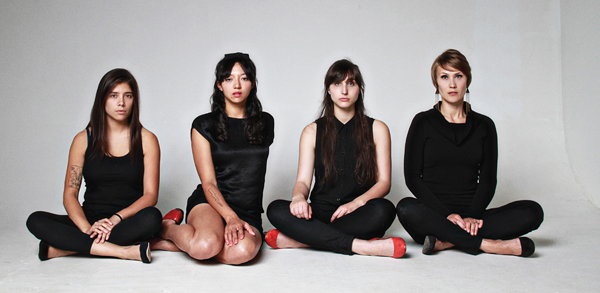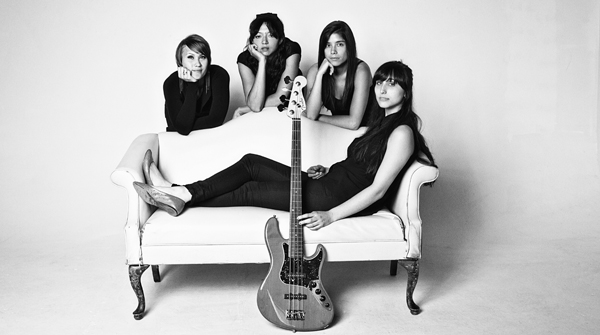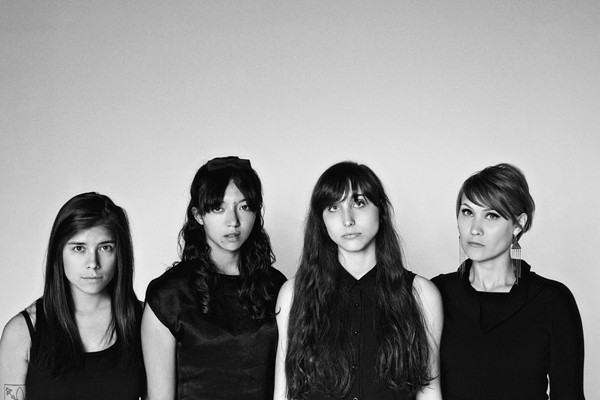The ripples of the reverb sway back and forth like the tides. This is surf music, an American tradition passed down to us from Frankie Avalon and Annette Funicello’s bandstand romps on the beach. But the bikinis and Wayfarers have a darker tint today, shaded by the towering redwoods and scattered driftwood on the shores. There’s no suntan to be spoken of; it’s much too cloudy. Frankie and Annette might have to throw on an extra layer if it gets any darker.
Traditionally, surf rock isn’t a genre laden with realism. It’s escapist at its core, an urge to run, not walk, board in hand to get away to the beach for a while. But in the Pacific Northwest, you’ll be a little harder pressed to find every day so sunny.
That’s where Seattle surf quartet La Luz comes into play. While the name translates to “the light,” the band’s debut full-length It’s Alive veers ironically into the darker side of surf, dropping expressive, damaged vocals over frenetically paced psychedelia.
 “It’s not just like sunny California pop,” says the band’s lead singer and guitarist Shana Cleveland. “I think of surf music as having a gothic vibe to it. The surf rock I like to listen to the most is Link Wray and Dick Dale and stuff like that. It seems like it always has a darker side than, like, the Beach Boys.”
“It’s not just like sunny California pop,” says the band’s lead singer and guitarist Shana Cleveland. “I think of surf music as having a gothic vibe to it. The surf rock I like to listen to the most is Link Wray and Dick Dale and stuff like that. It seems like it always has a darker side than, like, the Beach Boys.”
Supplementing Cleveland’s tenacious guitar hooks and blackened lyrical tone is a full-on assault of all-female vocal harmonies, drawing a haunting, lo-fidelity alternative to the glossy style of ’60s girl-group pop.
While the marriage of raging surf rock and glistening girl group could drown in overproduction, the band’s lo-fi attitude carries over into the recording process, a nod to Cleveland’s passion for cassette-tape aesthetics and the grimy garage style of artists like Shannon and the Clams, The Shivas and Ty Segall.
“When I was first writing the music for this band, [for] the first few songs that we played I was mostly inspired by stuff that was on cassette tapes,” Cleveland says. “It makes a lot of sense that we use kind of a lo-fi kind of recording because a lot of stuff I was listening to at the time I was hearing on cassette, so it was all kind of gritty and lo-fi.”
The band recorded It’s Alive, out now on Sub Pop’s sister label Hardly Art, in the same place as 2012’s Damp Face EP: a trailer park bedroom on the outskirts of Seattle. But Cleveland says the band was sure to take more care with the full-length to hammer out the particulars.
“We recorded the EP in a day and kind of mixed it in one more day,” Cleveland explains. “[We] just blew through it as fast as we could, just to have some tracks recorded. We went back over a couple weeks and did overdubs and spent a lot of time so we could have it mixed as we wanted.”
 That wasn’t the only change that La Luz undertook, however. Although It’s Alive shares a few tracks in common with the group’s earlier EP, the band added Alice Sandahl’s organ chops to its lineup in an effort to round out the surf vibe of the record.
That wasn’t the only change that La Luz undertook, however. Although It’s Alive shares a few tracks in common with the group’s earlier EP, the band added Alice Sandahl’s organ chops to its lineup in an effort to round out the surf vibe of the record.
“When I heard the EP I thought, ‘Holy shit, I love this shit and I need to be a part of this shit.’ I really loved hanging out with them and it’s been a magical experience,” Sandahl says.
Despite Sandahl’s reckless abandon en route to joining La Luz, the project has been years in the making. Cleveland and drummer Marian Li Pino had played the Seattle scene in K Records’ garage outfit The Curious Mystery, so when Cleveland set out to assemble an all-female band, Li Pino was a natural choice.
“I really liked the way we worked together, so when she asked me I was totally down,” Li Pino says. “It seemed like it would be really fun to play in this band, too.”
The addition of bassist Abbey Blackwell took more legwork, but once approached she was game.
“Shana was just looking for girl bass players and I kind of almost knew her,” Blackwell says to the laughter of her bandmates. “I’d heard her music before and I thought she was super cool so I was like ‘Yeah, sure, I’ll hang out with you guys and play music.’ ”
The creative process for La Luz has followed suit, with Cleveland handling songwriting duties before presenting ideas to the band for arranging.
“It ends up changing or evolving based on what people think makes sense,” Cleveland says. “I don’t have a hard or fast idea of how the song’s gonna go. We definitely have a lot of collaboration.”
One of the most crucial steps for the band, especially given its girl-group aesthetic, is combining sultry vocal harmonies to the instrumental backbone of its surf sound.
“Those are two of my favorite things to hear in music,” Cleveland says. “I have a feeling that backup vocals are coming back.”
 Cleveland’s affinity for tender harmonies layers distinctively against the band’s aggressive, guitar-driven surf backbone. But she enjoys the dynamic, the druggy haze of the band’s beach buzz, allowing her lyrics to shine between her ripping guitar solos. Suddenly, La Luz has carved out a unique style no Dick Dale or Diana Ross can lay claim to.
Cleveland’s affinity for tender harmonies layers distinctively against the band’s aggressive, guitar-driven surf backbone. But she enjoys the dynamic, the druggy haze of the band’s beach buzz, allowing her lyrics to shine between her ripping guitar solos. Suddenly, La Luz has carved out a unique style no Dick Dale or Diana Ross can lay claim to.
“I think there’s only benefits to having our own unique sound,” Cleveland says. “I feel like it’s pretty accessible music. It’s the kind of music that appeals to a lot of different kinds of people.”
After the band’s album release, the ladies will take to the road to open for psych-pop legends Of Montreal, turning their Pacific Northwest brand of goth-surf into a coast-to-coast wave. Blackwell describes the sudden rise in notoriety as something of a surprise. “I don’t think any one of us expected it to become this successful,” she says. “I had no idea what I was getting into, so how could I know?”
photos by Angel Ceballos



